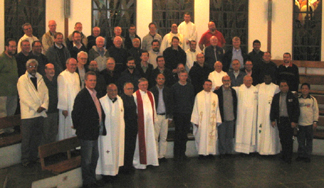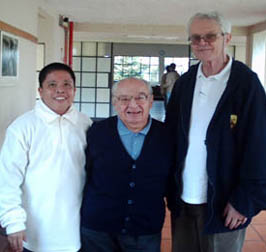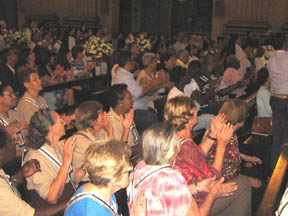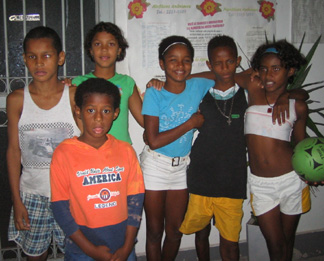|
no. 4 october - december 2005 OUR FUTURE: HOW ARE WE PREPARING TO FACE IT Participants at 2005 General Congregation discuss the needs of the Church and Order for the future W ith a nod to the statistics that appear to indicate the Order is growing most rapidly in the southern hemisphere, the 2005 General Congregation discussed how the Order might prepare for these changes. The General Council, having reviewed the statistics during its meetings, asked the question of how the Carmelites will serve the church and the world in this era of change."The theme for the General Congregation is not focused on our present problems or chosen out of fear. It is intended to help us look towards the future with faith and be faithful to the mission we have received from God," said Joseph Chalmers, Prior General.
One vocation program that has had extraordinary success is that instituted by the Pernambuco Province in 1982. Bishop Paulo Cardoso, who was Prior Provincial of the province when the program was started, and Francisco de Sales, the current Prior Provincial, were invited to make a presentation on the program. (see related article, page 5) Two initiatives are helping to change the Order’s financial situation. The income on the Domus Carmelitana, the hotel housed in a portion of the CISA building in Rome, has continued to increase its profits. The Society of the Little Flower in Great Britain and Ireland has provided grants of US$960,000 to support projects in Africa, Asia and Latin America since its foundation in April 2002. It has also provided for the endowment fund which has also been increased to US$1 million. "Clearly, a major issue for the future will continue to be finances. At present, the work of formation in the "south" is strongly supported or largely paid for by the provinces of the "north," said the Prior General. He went on to point out that with an aging and decreasing population in the "north" this source of funding would not continue indefinitely. Future Requires More Attention to Culture of the Order Patrick McMahon, praeses of the Institutum Carmelitanum in Rome, was also present for a portion of the meeting. He encouraged the provinces, commissariats, and delegations to take seriously their responsibility for the culture of the Order. During breaks, a power point presentation developed by the Institutum Carmelitanum focused everyone’s attention on the rich heritage that Carmel has and the need for the present generation to contribute for the benefit of this and future generations. Mark Attard, the General Delegate for Culture, spoke about the on-going project to collect information on advanced degrees held by members of the Order. He also reviewed the progress made by the Association of Carmelite Librarians during recent meetings and their plans for the future.
Renowned Peruvian theologian, Gustavo Gutiérrez gave the retreat to the members of the Congregation insisting that our eyes be constantly fixed on the goal of Christ and not the means. Using examples from the Scriptures, Gutiérrez made the connection between memory of the past that must be brought forward to the current day. He encouraged the members to guard against making anything absolute. "Liberation theology is relative. The Order of Carmel is relative," said Gutiérrez, one of the leaders in the Liberation Theology movement. "What is important is Christ." Gutiérrez suggested that the Order might wish to follow the example of the Old Testament Prophet Jeremiah who followed the will of God to buy a piece of land in Anathoth. This he said would be our declaration of where we stand. Government Commission Report Needs Further Work The 2001 General Chapter mandated a commission to study "the structure of the central government" and legislated that "this Commission will make its concrete proposals at the next General Congregation in 2005." The report, as well as a written report from the General Council, provoked some discussion and showed that there is little consensus on some of the key issues, such as the composition of the General Council and the role of the Vice General. It became clear that more work needs to be done in order to bring concrete proposals to the 2007 General Chapter. By a vote of 32 in favor and 4 abstentions, the members approved the creation of a new Government Commission which would use the services of an outside consulting firm which specializes in religious organizations. (See related article, this page) Meetings of the Regions Provide Rare Opportunity to Discuss Common Issues Taking advange of the presence of representatives from each Province and Commissariat, the members of the General Council held a series of "regional meetings." These gatherings often provide valuable discussions among the members of a particular region. The meeting of Northern and Central European Region with the Mediterranean Region, both of whom already meet separately each year, was a follow-up to their meeting in Fatima two years ago. They agreed to meet together in September 2006 for a more extended period on the theme of "How to Manage the Changes in Europe". Carmelite Family to Gather at General Chapter to Celebrate Rule and Discuss Common Issues The General Council proposed that the celebration of the 800th anniversary of the Rule be used as an occasion to bring together representatives of the entire Carmelite Family—cloistered nuns, Superiors General of affiliated congregations, and Lay Carmelites. The Order could take advantage of their presence to discuss with them some of the implications of our spirituality for the entire Carmelite family as well as other common issues. This celebration would occur sometime around September 17, the feast of St. Albert of Jerusalem. It was proposed that the Lay Carmelite Congress, which will take place in 2006, suggest some system of representation from among the many Lay Carmelite groups around the world. Overall some 50-55 people would be invited. The proposal passed 34 in favor and 2 abstentions. The traditional visit of the Prepositum General of the Discalced Carmelites to the General Chapter, together with some of his Council, will coincide with the celebration of the Rule. Members Asked "Are We Willing to Take the Risk?" In his closing address to the Congregation, the Prior General pointed out that the General Council had spent many sessions planning this meeting and reminded the participants that the purpose was to look forward. "I hoped we would listen to the Holy Spirit and to any ways the Holy Spirit might want to lead us." Picking up on the image of the prophet Jeremiah buying a piece of land which Gustavo Gutiérrez used during the retreat, Fr. Joseph asked, "Are we willing to take that kind of risk?" He recalled Gutiérrez’s observation that from trial comes hope using the presentation of the Pernambuco Province’s vocation project as one example. He reminded the group that the Province was ready to shut down but has begun to flourish anew. He said there is a movement towards beginning to see as God sees and to love as God loves. "We want to live this possibility with enthusiasm." He asked for God’s blessing on the whole Order and for Mary to continue to be with us in our work and lives together. "May they accompany us on the journey." While the participants met in small groups, the members of the General Council also met together. Besides dealing with routine business that had arrived since their May meeting, the Council took the opportunity to meet with various provincials and delegates to discuss particular situations in their Provinces. The meeting took place at Centro Santa Fe, a retreat center and educational center located on the outskirts of São Paolo.
One reason for holding the 2005 General Congregation in Brazil was to celebrate the refoundation of the Rio de Janerio Province by the Dutch Province in 1904. To close the anniversary year, the members of the General Congregation traveled to the Basilica of Our Lady of Mount Carmel in São Paulo to join with other members of the Carmelite Family from Brazil. The basilica was filled with the various groups of the Carmelite Family from around Brazil. They were treated to songs, presentations, introductions, and more songs. The organizers took the opportunity to show a multi-media presentation of the history of the Carmelites in Latin America. A Eucharist, led by the Prior General, Bishops Paulo Cardoso and Vitalis Wilderink, the three Brazilian Provincials and Provincial Commissary and the Provincial of the Dutch Province, became a festive celebration of the whole Family. Following the Mass, the members of the General Congregation were hosted for dinner in the monastery refectory. The website for the 2005 General Congregation is available at: carmelites.info 1) Glimpses from the 2005 General Congregation include culture, family and work that occurred during the 10 day meeting in Brazil. 2) Some of the Carmelite Family gathered for the celebration of the closing of the 100th anniversary year of the refounding of the Rio de Janeiro Province by the Dutch Province (CITOC photo) 3) Participants of the 2005 General Congregation pose for the traditional picture in the chapel of Centro Santa Fe, São Paulo, Brazil.
Reconstitution of the ad hoc Commission on Government At the 2005 General Congregation held in São Paolo, it was decided to ask the Commission on Government to continue its work in preparation for the General Chapter of 2007. The Prior General and his Council, in putting this proposal into effect, decided in session 203 held on 12 October to appoint Emanuele Boaga (Ita), Wilmar Santin (GerS- P) and Manuel Bonilla Gutiérrez (Cat) as members of the Commission. They will assist Josef Jancar O.Carm., the Procurator General, in examining the suggestions made at the General Congregation and in drawing up proposals for the General Chapter. These members will meet with the Prior General and his Council on 9 December 2005 in the Curia during the plenary sessions of the Council.
During the evening advertised as "Cultural Night" the participants in the General Congregation were treated to a display of cultural dance and local dessert by members of the São Martinho Community from Rio de Janeiro. One highlight of the evening was when some of the provincials briefly joined in dancing with the young people. The program is connected to the St. Elias Province (Flum) of Brazil. São Martinho is "a family" of street children between the ages of 6-18 years. It serves a large number of young people from around the Rio de Janeiro area with a variety of programs. Each program is designed to meet the needs of a particular group of children. The young people and their adult leaders had traveled several hours by van in order to meet the members of the General Congregation and to show their dancing skills.
Some programs are as simple as the art workshops for creating wooden toys, jewelry and teaching street dancing, sewing, and recriare (recycling of materials) which develops self-esteem and skills. Over 230 children took part in these workshops in 2004. Other programs provide more intense care and education. The Socio Education Center (CSE) offers day shelter to children who would otherwise be on the street. The goal is for the children to return to their families. They are guaranteed the right to personal hygiene, medical and psychosocial care, and three daily meals. In 2004, over 3225 children attended the Socio-Educational Centre. When re-integration is not possible, the child has the possibility of living in one of the São Martinho group homes.
The São Martinho Family has close ties with the Netherlands. In 2003, the Queen of Holland visited to acknowledge this connection. Princess Diana of Britain also visited a São Martinho community. To learn more about the São Martinho Family, go to: www.saomartinho.org.br/ 1) The viaduct in Rio de Janeiro where some of the São Martinho children sleep. 2) Some of the crafts being examined by Fr. Aureliano Pacciolla (Neap) and some of the children from São Martinho 2) Some of the 45 residents of the São Martinho Family home located in the Carmelite parish in the Vincente de Carvalho area of Rio de Janeiro. (CITOC photo) |
|
RETURN TO THE INDEX FOR 2005 | RETURN TO THE INDEX FOR THIS ISSUE INDEX OF CARMELITE
WEBSITES |

 The overall statistic for the number of members in the Order have
remained relatively static since 1996. However, during those years we have
withdrawn from two countries in Europe and opened eight foundations in
countries new to the Order and in the southern hemisphere. The number of
friars in the so-called "north" (Europe, USA, Canada, and Australia) has
declined while the number in the "south" has increased.
The overall statistic for the number of members in the Order have
remained relatively static since 1996. However, during those years we have
withdrawn from two countries in Europe and opened eight foundations in
countries new to the Order and in the southern hemisphere. The number of
friars in the so-called "north" (Europe, USA, Canada, and Australia) has
declined while the number in the "south" has increased.


 Founded 20 years ago, São Martinho has helped rescue children
and adolescents who live in the streets of Rio, promoting their
re-integration into a family. The organization promotes the young people’s
education, strong family bonds, acts as the social and legal defense of
the children, and facilitates the entrance of the young people into the
labor force. Part of the organization’s mission is also to cooperate with
the formulation and implementation of public policies related to children.
Founded 20 years ago, São Martinho has helped rescue children
and adolescents who live in the streets of Rio, promoting their
re-integration into a family. The organization promotes the young people’s
education, strong family bonds, acts as the social and legal defense of
the children, and facilitates the entrance of the young people into the
labor force. Part of the organization’s mission is also to cooperate with
the formulation and implementation of public policies related to children. The homes provide shelter and protection to the children, always with
the goal of re-integration into their own family. There are three such
homes in Rio de Janeiro and two in Niterói. In each house, the children
take part in the routine chores, including cleaning up, helping in the
kitchen, and set schedules for study and play. All of the sheltered
children are registered and attend schools. Contact with the parents is
maintained through visits to the child’s home. The visits serve to
discover the reasons the child left the family and to take measures to
re-integrate the child into the family.
The homes provide shelter and protection to the children, always with
the goal of re-integration into their own family. There are three such
homes in Rio de Janeiro and two in Niterói. In each house, the children
take part in the routine chores, including cleaning up, helping in the
kitchen, and set schedules for study and play. All of the sheltered
children are registered and attend schools. Contact with the parents is
maintained through visits to the child’s home. The visits serve to
discover the reasons the child left the family and to take measures to
re-integrate the child into the family.